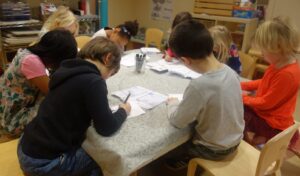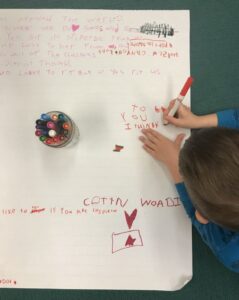Why Put Our Ideas Into the World?

The Cottonwood Community of kindergartners and first-graders has spent the last several weeks preparing to publish small moment stories that children have written from their lives. The children have taken care to slow down and zoom in on the small details inside these moments. After writing a first draft, the children received their first editing and/or revising checklists and went through the process of revisiting their work, receiving feedback from peers, making choices as authors, and ultimately preparing their stories to be published.
When asked, Christian (first grade) described the care the children have put into these stories:
This is how it works…with writing, you can’t just snap your fingers and be done right away. If you want the best story, it takes days of believing, playing with your words, believing in your story, and working hard… It takes time.

Lauren and I noticed that the desire to share their stories with others in some capacity was consistent throughout the community. This led us to wonder about the “why” behind writing. Why do the children think writer’s write? Why do they want to write? Who do they write for? Why do they want to publish? What feels powerful about publishing?
Earlier this month, we began Story Workshop by asking the children, “Why do you think writer’s write?”
Timothy: So other people could see it.
Isaac: [Authors] want to write it down… because they have a good memory in their head.
Harper: They feel happy when people read their ideas. Maybe the kids might get interested or inspired.
Abigail: Because if you just did pictures people might not understand only the pictures.
Dustin: To share with the world.
Here, we noticed the children highlighting the desire to make their ideas visible to others and to inspire other people. Their drive to share ideas with the hope of inspiring someone else was curious. We wondered about their experiences of feeling inspired by a story and this desire to share the experience with others. Lauren asked the children during a whole group meeting, “What is is about reading or seeing someone else’s ideas that feels good to you?”
Timothy: It’s amazing because they can do different things that you can’t do!…Like I can’t fly, but in a book people can fly! So, it’s really cool to see that in a book, someone can really fly!
Christian: It’s because you might want to read it but it could leave you with a cliffhanger. I like that you can make predictions, it’s fun! When you go to read it again, it undoes the cliffhanger. And then you can see if your prediction was right or wrong.
Abigal: When you read a book the pictures might inspire you. It might inspire you to write a book like we did with Cookie’s Week.
Simon: It might inspire your life too! If it’s nonfiction, it means it must be real. If it’s about a [character] you really like, and they’re doing something really good, it might teach you to do that even better!
Lauren and I noticed so much excitement for next steps embedded within this dialogue. The children described the process of absorbing someone else’s ideas, thinking about them, and then allowing those thoughts to propel them forward in different ways. Perhaps this forward motion looked like imagining something they had never imagined before, puzzling over what might come next, recording their new ideas and connections while absorbing a story, or learning to do something new.
As teachers, this led us to wonder about the power of the “we” within the context of sharing our stories. Specifically, what is possible for an individual’s idea, when it is shared with others, left open for the reader to interpret, for the reader to take their own next steps based on their unique interpretation of a text? How might the idea change? How might an idea grow in ways that it wouldn’t have if it hadn’t been shared with a larger audience? What is the value of growing ideas in this way? What is the value, to an author, of publishing their work?
Soon the children will be putting copies of their published stories into the Little Free Library in front of Portland Children’s Museum. Along with a letter from Cottonwood children and teachers, our books will have postcards inside them, inviting a response from the reader. We all are so excited about the possibilities for the possible inspiration and the growth of ideas through sharing our writing with a larger audience.

We are wondering:
Who are the audiences for the young writers you work with?
What authentic opportunities to share children’s stories are you finding in your classroom communities?
How do these authentic opportunities support children to grow ideas together?
Why does it matter for young children to think about who their audience is? …consider a wider audience?
